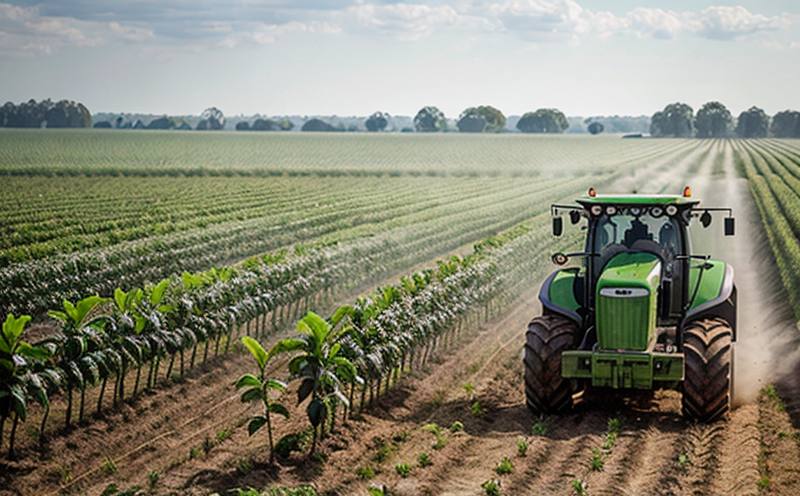UNE EN 1528 Agricultural Organochlorine Testing in Foods
The European standard UNE EN 1528: Determination of organochlorine residues in foodstuffs – Extraction method using acetonitrile and dichloromethane (DCM) is a critical tool for ensuring the safety and quality of agricultural products. This standard plays an essential role in safeguarding consumers from potentially harmful pesticides, particularly those classified as organochlorines, which have been banned or restricted due to their adverse effects on human health.
The application of this standard is particularly relevant in the agricultural sector where residues from certain pesticides can migrate into foodstuffs. Organochlorine compounds are known for their persistence and bioaccumulation properties, making them a significant concern for both producers and consumers. Compliance with UNE EN 1528 ensures that food products meet stringent safety standards set by regulatory bodies.
The standard specifies detailed procedures for extracting organochlorines from various types of foodstuffs using acetonitrile and dichloromethane, followed by analysis via gas chromatography or liquid chromatography coupled with mass spectrometry. This extraction method is chosen for its efficiency in isolating target compounds while minimizing interference from other components.
Compliance with this standard not only ensures food safety but also builds consumer trust and enhances the reputation of agricultural producers. By adhering to UNE EN 1528, companies can demonstrate their commitment to quality assurance and regulatory compliance, which is crucial in maintaining market access and competitive advantage.
Scope and Methodology
| Type of foodstuffs | Extraction method | Pesticides tested |
|---|---|---|
| Fruits, vegetables, grains, seeds. | Acetonitrile and dichloromethane extraction followed by gas chromatography/mass spectrometry (GC/MS). | Organochlorine pesticides such as DDT, aldrin, endrin, dieldrin, heptachlor, methoxychlor, and toxaphene. |
The scope of UNE EN 1528 is broad and encompasses a range of foodstuffs including fruits, vegetables, grains, seeds, and other agricultural products. The extraction method involves the use of acetonitrile and dichloromethane to extract organochlorine residues from these samples. This method ensures that even trace amounts of pesticides are efficiently isolated for further analysis.
The standard covers several organochlorine pesticides such as DDT, aldrin, endrin, dieldrin, heptachlor, methoxychlor, and toxaphene. These compounds have been historically used in agriculture but are now restricted due to their toxicity. The extraction process is designed to accurately quantify these residues, ensuring that they do not exceed allowable limits set by regulatory authorities.
The methodology outlined in UNE EN 1528 involves several key steps:
- Preparation of the sample according to specific guidelines.
- Extraction using a mixture of acetonitrile and dichloromethane.
- Clean-up procedures to remove interfering compounds.
- Analysis via gas chromatography or liquid chromatography coupled with mass spectrometry (GC/MS).
Customer Impact and Satisfaction
The implementation of UNE EN 1528 has a profound impact on the quality and safety of agricultural products, which directly benefits customers. By ensuring that foodstuffs are free from harmful organochlorine residues, this standard enhances consumer trust in agricultural producers and processors. This, in turn, leads to higher customer satisfaction and loyalty.
For quality managers and compliance officers, adherence to UNE EN 1528 provides a clear framework for meeting regulatory requirements. It simplifies the process of ensuring that products meet stringent safety standards, thereby reducing the risk of non-compliance penalties. For R&D engineers, this standard offers a robust foundation for developing new testing methodologies and improving existing ones.
From a procurement perspective, compliance with UNE EN 1528 ensures that suppliers adhere to high-quality standards. This not only enhances product quality but also supports sustainable agricultural practices by promoting the use of safer pesticides.
Competitive Advantage and Market Impact
Compliance with UNE EN 1528 is essential for maintaining a competitive edge in the global market. Consumers are increasingly aware of the risks associated with organochlorine residues, making it imperative for companies to demonstrate their commitment to food safety through rigorous testing protocols.
By adhering to this standard, agricultural producers and processors can differentiate themselves from competitors who may not meet such stringent requirements. This not only enhances market reputation but also opens up opportunities for export markets where compliance with international standards is mandatory.
The competitive advantage gained from UNE EN 1528 extends beyond just meeting regulatory requirements. It allows companies to build a strong brand image based on quality and safety, which can lead to increased sales and customer retention. In addition, it fosters innovation in sustainable agricultural practices and safer pesticide use, contributing positively to the environment.





